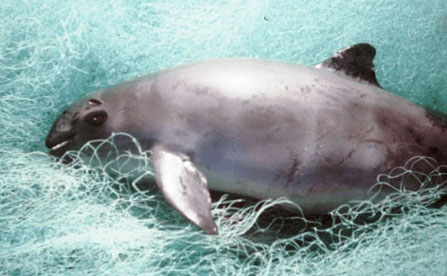Last ditch effort: Mexico steps up protection to save the Vaquita Porpoise

The Vaquita porpoise has rarely been photographed; most of the available images are of dead animals caught in fishing nets. Photo: courtesy of Cousteau.org.
GULF OF CALIFORNIA
“What you do to the smallest of my brothers you do to me” - Mexican folk song
As a means of saving the fewer than 100 individuals left of the Vaquita porpoise (Vaquita Marina, Phocoena sinus), a small cetacean endemic to the upper Gulf of California, the protected marine area has been increased by 2.9 million acreas.
According to the Secretariat of Environment and Natural Resources (Semarnat), the enlargement of the marine zone is part of a program that includes: economic compensation of fishers; intervention by the military and federal environmental and fishing agency officials within the zone to ensure improved inspection and surveillance; and the introduction of new fishing techniques.
The Vaquita seems headed inevitably towards extinction. Or at least that's what the constant decline in the population of this marine mammal, which inhabits the most productive fisheries in Mexico, indicates.
There are many fishers and inhabitants of coastal towns surrounding the Vaquita’s protected area who doubt the animal’s existence. That isn't unusual, since it is an animal that has only been photographed a few times; most of the images circulating are of dead animals found by fishers in their nets.
Even so, and thanks to pressure from the international scientific and conservation communities, the Mexican government has decided to launch a final and desperate effort to save the Vaquita from extinction.
In the watershed year of 2015, Semarnat has announced that their strategy includes a complete 2 year fishing ban in the area, during which time fishers will receive a subsidy, and will be employed as community police to protect the species.
The Mexican government will allocate at least 1.082 million pesos (some 72.6 million dollars) towards these actions.
The Vaquita is endemic to the upper Gulf of California and is the world’s smallest cetacean. It has the most restricted range of any cetacean and is the most endangered of the 128 species worldwide.
The conservation NGO Greenpeace Mexico considers that Semarnat’s announcement of the 2 year fishing ban in the upper Gulf of California has arrived very late in the fight to try to save the remaining 97 Vaquita porpoises.
“Although the measures announced are a huge first step in the protection of the Vaquita, we can't lose any more time. The program was expected to become effective as of March, so we mustn’t lose yet another minute in its implementation. It’s imperative that we move from promises to actions,” claims Sylvia Diaz, head of the Greenpeace Oceans program.
Greenpeace adds that with the Mexican government’s announcement that it will buy drones and fast boats to patrol the area, and compensate fishers, what also needs to happen is a plan for developing sustainable fishing techniques in the communities of San Felipe and Santa Clara in the upper Gulf of California, a location where fishing is the principal economic activity.
They mention that the illegal fishing of totoaba, another endangered species whose value on the black market in Mexico and China is extremely high, has increased dangerously within the Vaquita’s range over the last 2 years, causing the Vaquita population to plummet alarmingly.
“The federal government’s initiatives are positive but more is needed. The high black market value of the totoaba, and the fact that organized crime is becoming involved in its fishing and illegal trafficking, makes fighting these practices much more complicated,” adds Diaz.
